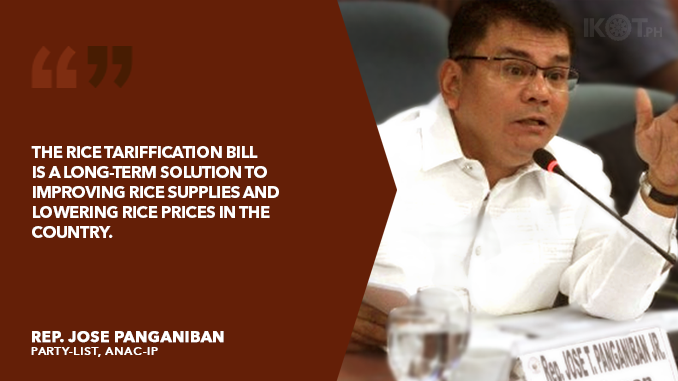House Agriculture Committee Chair and Anac-IP Party-list Rep. Jose T. Panganiban, Jr. on Friday expressed confidence that the rice tariffication bill would be approved on third reading on Monday.
The House of Representatives terminated sponsorship and debates on House Bill 7735, or the “Revised Agricultural Tariffication Act,” last Wednesday. The Senate version is still being deliberated on at the committee level.
Panganiban, the bill’s sponsor, also said that when passed, the rice tariffication law would be the third significant measure passed during his tenure as Agriculture Committee Chair.
“We have already passed the free irrigation law. Also this week, the coco levy trust fund bill hurdled the bicameral conference committee. I hope we can soon add the rice tariffication law to the list of high-impact legislation passed for the benefit of our farmers,” said Panganiban.
“We have already passed the free irrigation law. Also this week, the coco levy trust fund bill hurdled the bicameral conference committee. I hope we can soon add the rice tariffication law to the list of high-impact legislation passed for the benefit of our farmers.”
The legislator reiterated the need to pass the rice tarrification bill as part of long-term measures to make rice more affordable for the poor.
“Rice prices today make it increasingly unaffordable for many families, especially the poor and our indigenous peoples (IPs) who depend on this staple,” said the lawmaker.
“Rice prices today make it increasingly unaffordable for many families, especially the poor and our indigenous peoples (IPs) who depend on this staple.”
“Today the average retail price of regular milled rice is roughly 41 pesos per kilo, a figure that can be reduced by seven pesos per kilo if this measure is passed. Malaking tulong yan sa mga kababayan natin na hirap na sa pagba-budget sa mga pangangailangan ng pamilya. (This is a big help for our countrymen who are having difficulties budgeting for the needs of their families.)”
Government economic managers estimated that liberalizing rice imports would bring down the price of rice by as much as 7 pesos per kilo. The Bangko Sentral ng Pilipinas (BSP) also said this measure is estimated to lower inflation by 0.2 percentage points if it is rolled out by the fourth quarter of the year.
The rice tariffication bill will lift the quantitative restrictions (QR) on rice imports, and instead liberalize rice importations while imposing a 35 percent tariff.
In his third State of the Nation Address on July 23, the President announced that he would certify the rice tariffication bill as urgent and called on Congress to prioritize its approval.
“We need to switch from the current quota system in importing rice to a tariff system where rice can be imported more freely. I ask Congress to prioritize this crucial reform, which I have certified as urgent today,” said Duterte in his speech.
Panganiban agreed, saying that the rice tariffication bill was a long-term solution to improving rice supplies and lowering rice prices in the country.
“Six years ago, the average retail price of regular milled rice was 32.4 pesos a kilo––almost ten pesos less than it is today. Obviously, there is something wrong, a confluence of different factors affecting rice supplies and prices, like natural disasters hitting local production, or rice traders artificially manipulating prices,” explained the solon.
“Whatever the case, liberalizing the entry of rice and levying a tariff on this staple has long been a proposal put forth by respected economists, and the President should be commended for having the political will to push for this.”
The World Trade Organization allowed the Philippines to impose a 10-year QR on rice imports in 1995, after which it was extended in 2004 until 2012, and renewed in 2014. Another extension was granted until June 30, 2017.
Aside from lowering inflation, the Department of Finance (DOF) said the proposed 35 percent tariff on rice imports would generate 27.3 billion pesos in additional revenues for the next six years, funds that could be tapped to aid local farmers and make them more competitive, such as farm-to-market roads and irrigation.


